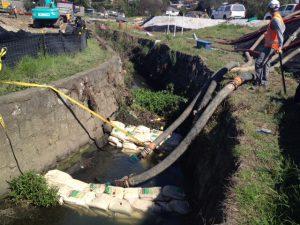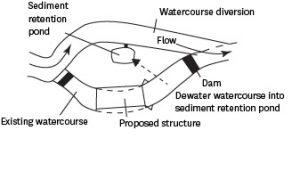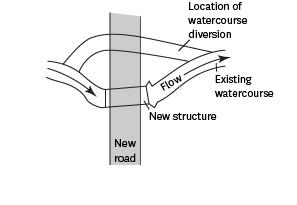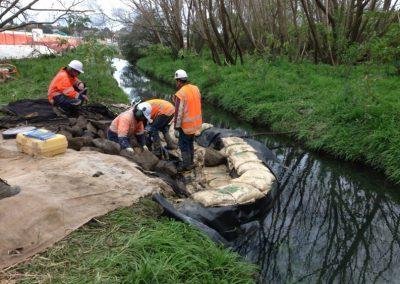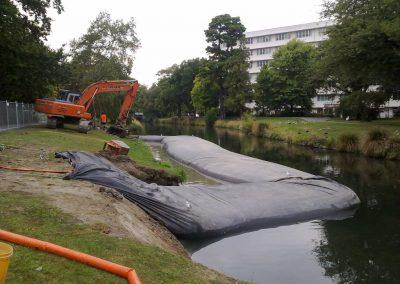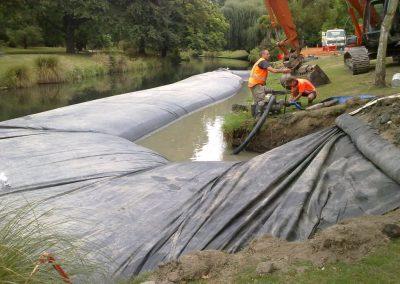Specific Tasks
Waterways
Diversions
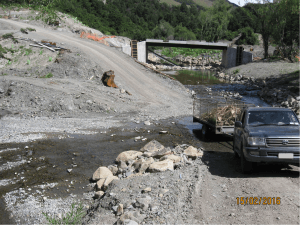
Construction of the bridge used a diversion of the river to isolate the bridge works area from flowing water.
Diversion methodologies help provide dry working conditions for when you are installing a culvert. The usual approach is to divert flow from above the site. The flow can then pumped around the site (for short projects only), conveyed through a temporary drainage coil or plastic flume, or through a stabilised channel.
This toolbox gives details on these three methods:
- Dam and pump, or dam and divert, devices
- Temporary diversion channels
- Coffer dam
Any diversion works within a waterway will require ongoing and vigilant maintenance to minimise sediment generation. To achieve this, identify and correct any signs that may indicate a potential problem. Take particular notice of the following signs and make repairs immediately:
- The geotextile lining ripping
- Scour occurring where the flow re-enters the channel
- Undercutting of the diversion lining
Dam and pump, or dam and divert, devices
What, why, when and issues to look out for
What
A dam and pump or a dam and divert are temporary practices that convey surface water from above a construction activity to downstream of that activity.
The dam must be able to hold back the incoming flows. The pump must be able to convey the flows, because overtopping the dam will cause environmental and construction issues with flows passing through the work site.
-
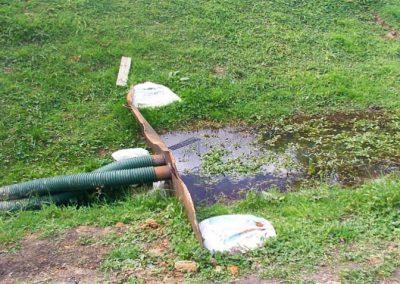
Water in a small stream being diverted past a construction works area (Source: SouthernSkies Limited).
-
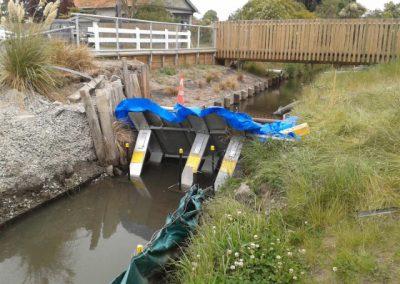
Dam in place and overpumping underway (Source: Downer).
-

Dam in the creek and water being pumped around the work area (Source: Downer).
Why
Damming a stream and pumping the flows around the worksite back to the stream considerably minimises disturbance relative to constructing a new diversion channel.
When
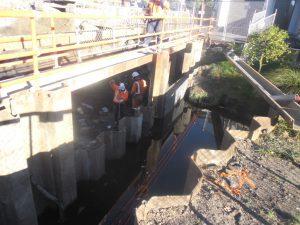
Engineers are able to work in relatively dry conditions by pumping the stream’s flow from behind the dam and around the work area (Source: Downer).
With high flow streams, diversions are sometimes the only option; however with most small streams, damming and pumping are less harmful to the environment and relatively simple to carry out. The dam is also essential to the temporary waterway diversions that are discussed next.
Issues to look out for
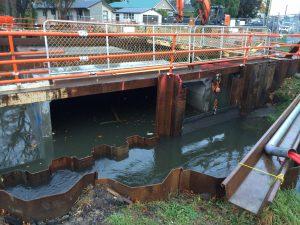
A sheet-pile dam used to isolate the work area. Here a clutch plate has been lifted to allow high flows past (Source: Downer).
- You can only use dam and pump for works with a short duration or when you can stabilise the site at the end of each work day, so that flows can continue through the stream channel
- Pumps can lack the capacity to handle unexpected larger flows
- The pump might run out of fuel while unattended
- Because of noise and also pump reliability issues, it is usually not a good idea to use a dam and pump methodology if the pump needs to be operating day and night throughout the operation
Design essentials
- Construct a dam across the stream (upstream and downstream of the instream works) with stabilised materials such as sand bags, sheet metal plate or other suitable construction materials
- Remove all fish (including eels) from the section of waterway to be dewatered, or worked in. Use suitably qualified or experienced people to do this work. Transfer the fish and eels to suitable habitat
- Install a pump in the dam, with enough hose length to reach below the extent of instream works
- Place the pump inlet in a drum with holes to minimise the possibility of sucking sediment from the bottom of the dam. We recommend that you include a fish screen
- Direct the outlet to a stabilised area with an energy dissipater, eg rip-rap boulders or geotextile cloth pinned down to the banks and bed of the waterway where water is being released
Sizing of the pumped diversion for a given storm event depends on how long it needs to be in place. As a minimum, the temporary pumping should be sized for a one-year peak discharge from the contributing catchment. These design parameters are based on the assumption that full channel 5% AEP (20-year) capacity is made available overnight or when storm events are predicted.
Temporary diversion channels
What and why
What
These are short-term waterway diversions that allow work to occur within the main waterway channel under dry conditions.
-
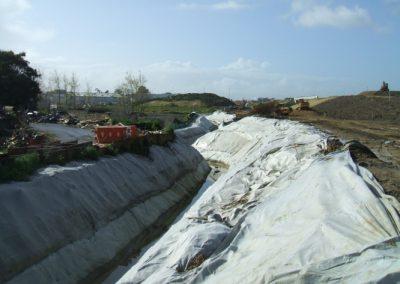
Temporary stream diversion installed to allow permanent culverts to be installed off line (Source: SouthernSkies).
-
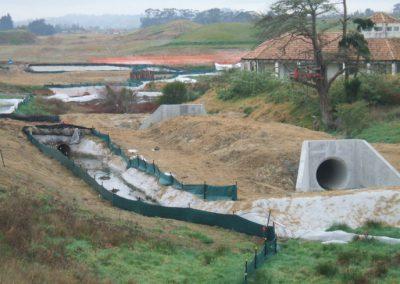
Temporary stream diversion installed to allow permanent culverts to be installed off line (Source: SouthernSkies).
Why
Temporary waterway channels and diversions enable instream works to be undertaken without working in wet conditions and without moving sediment into the waterway.
-
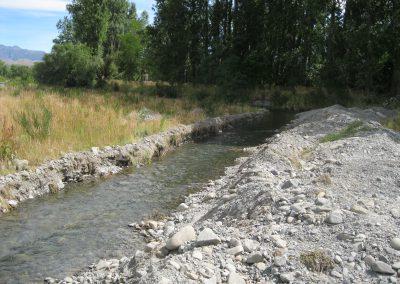
Temporary river diversion channel cut to move water around the works. Trenching and pipe installation can be carried out with minimal water entering the work area.
-
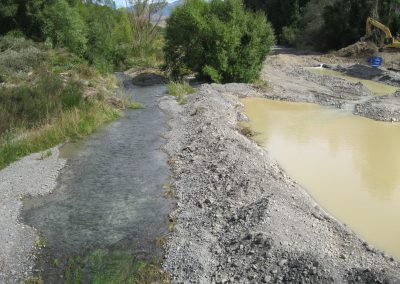
Water from the diversion upstream joins a natural braid of the river behind the willow tree. Trenching work and pumping dirty water to the settling ponds is effectively separated from moving water.
Design essentials
These measures divert all flow via a stabilised system around the area of works and discharge it back into the channel below the works to avoid scour of the channel bed and banks. The figures show the suggested steps to minimise sediment generation and discharge from works within a waterway.
Step 1 – the diversion channel
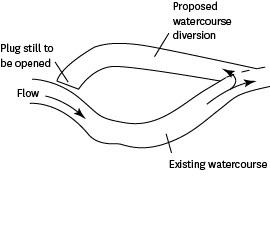
The diversion channel is excavated leaving a plug at each end so that the waterway doesn’t breach the diversion. Once the channel is stabilised, the lower channel plug is removed, and then the upstream plug.
Excavate the diversion channel leaving a plug at each end so that the waterway does not breach the diversion.
Size the channel to allow for a 5% AEP rain event, but consider the implications for secondary flow paths and upstream flood effects of having a larger event, of up to 1% AEP.
Stabilise the diversion channel appropriately so that it does not become a source of sediment. Anchor suitable geotextile cloth in place to the manufacturer’s specifications, which will include trenching into the top of both sides of the diversion channel to be sure that the fabric does not rip out.
Once the channel is stabilised, open the downstream plug to allow water to flow up the channel, keeping some water within the channel to reduce problems when the upstream plug is excavated. Then open the upstream plug, allowing water to flow into the channel.
Step 2 – the dam
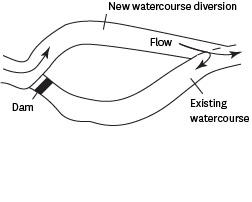
All flow is diverted down the new channel once an non-erodible dam is placed in the existing watercourse bed.
Place a non-erodible dam in the upstream end of the existing channel. The dam should be installed as shown in the adjoining diagram. If you are using a compacted earth bund, stabilise it with an appropriate geotextile pinned over the upper face and adjacent to the lower face for scour protection. In most cases, sandbag dams of sheet metal plates are used to construct the dam.
If you need to relocate fish trapped in the existing waterway as a result of the diversion, contact a suitably qualified person to capture and transfer the fish.
Step 3 – dewatering
Install a non-erodible downstream dam to prevent backflow into the construction area. You can then drain the existing waterway by pumping to a sediment retention pond, where the ponded water can be treated before it re-enters the live section of the waterway.
Have all fish and eels removed from this section of the stream or river prior to dewatering, by a suitably qualified or experienced person. Transfer the fish and eels to suitable habitat.
The structure and all channel work are then completed.
Step 4 – re-establishment
Remove the downstream dam first, allowing water to flood back into the original channel. Then remove the upstream dam, and fill in both ends of the diversion channel with non-erodible material. If there is any sediment-laden water, pump it to a sediment retention pond or dewater it. Then fill in and stabilise the rest of the diversion channel.
Coffer dam diversions
General comments
In some circumstances, you will need to partially divert a waterway to allow for the construction of outfall structures or streambank retaining works. A coffer dam may be used to create a dry working environment to complete the works.
The coffer dam will generally be constructed within the streamflows. As such, it needs to be of non-erodible material such as sand bags, sheet piles or similar. Once complete, the water retained by the coffer dam within the work area is pumped out to provide the dry working area. Any dirty water within the coffer dam during the works will need to be pumped to a sediment retention device (see Dewatering section).
The coffer dam design will need to take into account the height of water to be diverted including any likely increased flows within the construction period.
Use a suitably qualified or experienced person to remove all fish and eels from the area that is dammed. Transfer the fish and eels to suitable habitat.
